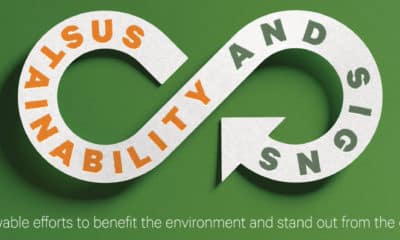Growing up in Cleveland, I learned how acutely a bruised ecosystem can wear down a city’s reputation. The Cuyahoga River burned in 1969, shaping a generation’s perception of the Rust Belt city.
So it is with sustainability in the sign industry. When people reminisce about fume-laden tradeshows and dumping old inks down the drain, I know those are hallmarks of a bygone era. Yet, the sign industry, like Cleveland, still has work to do.
As Cleveland approaches the 50-year anniversary of the fire, much has changed. Today, I spend more time explaining that Akron is not a Cleveland suburb than defending the waterways I swam in as a child. LeBron James has moved on (again), but Clevelanders will always thank him for positively altering the city’s story – and sports history.
And I’m thankful to see growing interest in low-solvent inks, take-back recycling programs, post-consumer material use in newly manufactured products, and a spate of environmentally conscious certification programs.
We can’t discuss sustainability without acknowledging its spectrum of subscribers. I attended a Sustainable Green Printing Partnership meeting late last year, where participants spoke of clients who will only work with sustainable shops, which fuels referrals in this close-knit community. I’ve also heard from small business owners whose survival would be threatened by implementing certain sustainable practices.
But bigger than whether old sign materials are recycled or retrofitting with LEDs are questions about the future of the sign industry, the decline of certain sign crafts, succession planning and the looming need to recruit and retain the next generation.
Advertisement
Company culture, work-life balance and incorporating technology are notable concerns for younger folks. Keeping craft alive (and small signshops open) has primacy for those who witnessed the heyday of neon bending, pinstriping, signpainting, gilding and more. Therein lies a divide.
People in Minneapolis, Chattanooga, Boise, Missoula and Raleigh have witnessed the positive effects of a population boom that draws in that next generation. The sign industry needs that influx, as well. Events like the annual ISA Sign Manufacturing Day and sponsored tradeshow admissions help. But industry leadership in this area of growing interest is essential to attracting that next generation. When we consider the need to keep signcraft alive, sharing it with kids should be at the forefront.
My peers are moving back to Cleveland today in surprising numbers. Sign industry manufacturers have waded into the waters of environmentally friendly production and products. Whether they succeed or fail is up to us. This issue is dedicated to that question.


 Tip Sheet3 days ago
Tip Sheet3 days ago
 Business Management2 weeks ago
Business Management2 weeks ago
 Women in Signs2 weeks ago
Women in Signs2 weeks ago
 Real Deal4 days ago
Real Deal4 days ago
 Editor's Note1 week ago
Editor's Note1 week ago
 Benchmarks15 hours ago
Benchmarks15 hours ago
 Line Time2 weeks ago
Line Time2 weeks ago
 Product Buying + Technology1 week ago
Product Buying + Technology1 week ago
















